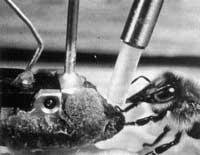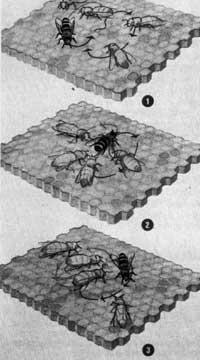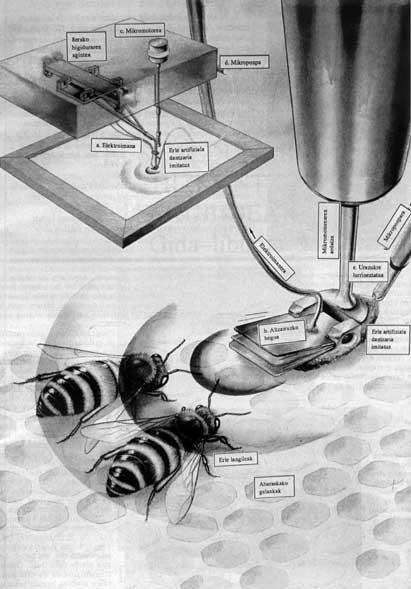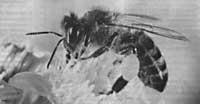Dialogue with bees
1990/12/01 Otaolaurretxi, Jon Iturria: Elhuyar aldizkaria
When in 1927 Nobel Prize-winning scientist Karl von Frisch began to understand the language of bees, J.B.S. The English biologist Haldane said: One day we will be able to send our bees flying for five minutes southeast and sprouting this apple tree. For this we need a model of bees. This model must make proper movements and may have to emit sounds and smells.
About sixty years later, this prediction has been fulfilled through the electronic bee. These are the electronic bees that translate human language into the language of bees.
Although so far it had not been invented how to translate, the language of bees was already well known. Karl von Frisch discovered that bees inform each other through two rhythmic movements or types of dance. There are circular dances and others that form the form of 8 figures.
Circular dance means that food is less than 100 meters away and dance 8, which is further away.

Scientists did not at first accept this surprising discovery, but certainly von Frisch definitely clarified things. During the broadcast of a series of lectures in North America, listeners did not teach him as usual heat in his discoveries. Von Frisch wanted to express to his listeners the dances performed by the bees in the wax honeycomb of the glass hive. However, in order for the bees to dance, they had to have said, for example, that at a certain distance from the hive there was food in a certain place.
To do this, Mr. von Frisch commissioned an assistant to leave and hide the honey pot and a few bees from the rehearsal room. Like the scientist, the bees went from the honey boot to the hive and communicated to their co-workers where the honey was by dances.
At the end of the talk, von Frisch wanted to recover the honey pot, but his assistant did not appear. Then the scientist's wife told her husband publicly: Why not ask them where the honey pot is?
Von Frisch measured the rhythm of the dances with the chronometer to the bees and the angle that formed the body of the dantzaris with the vertical through the door-angles. Knowing precisely this data, the speaker left with his listeners in search of the boat and found it right away.
With the electronic bee one more step is taken in bee communication. Danish scientists Michelsen and Andersen at the University of Oabe, German researchers Kirchner and Lindauer at the University of Wurzbourg, have prepared a special artificial bee. It has the ability to inform common bees and send bees to a particular point chosen by man.
These scientists have taken as a basis for their work the rhythm of dance (the rhythm is inversely proportional to the distance to the place where the food is located) and the direction (the direction is defined with the angle formed by the directions to the Sun and the place of food).
This angle is replaced in the ledge by the angle that forms the body of the dancer with the vertical when it is vibrating. Remember that the combs are vertical.
Also, sound is important. Thanks to the vibration of the wings, the bees take out a special prank and so information is exchanged.
Finally, the dancing bee gives workers a little nectare collected at their departure, providing chemical information.
The artificial bee takes all this into account when it has to work. It is a piece of waxed copper that somehow mimics the shape of the bee. It also has a part of the razor blade.
Through the microcontrols and micromotors that are governed by a program, the artificial bee dances in 8 ways, properly modifying the axis of the bee to the vertical. The artificial south also vibrates thanks to an electromagnet and emits frequency sounds of the royal bees. In addition, periodically a small pump sends some water sugar to reward the bees approaching the robot.
The artificial bee is inside the hive before it starts working, as it is contaminated with local smells and worker bees do not take it as strange.
The artificial bee has had a great communication success. He has informed working bees that there is food in an unknown place, and they have understood the message. Data transmission is not as accurate as between natural bees, but transmission does exist.

A bee that finds flowers of interest returns to the hive to inform its companions. To do this he performs a special dance in the form of 8 figures reclining in the honeycomb. Your bee understands what this dance means and so they know where to go in search of flowers. Between the central and vertical axis of the 8 is the same angle between the sun and flowers. (In the hive the honeycombs are vertical, although we have placed them horizontally to see better here). At the same time, the dancer vibrates the wings while using his body in zigzag. Indicates the distance to which food is found and whether there is much or little. Behind the dantzari worker bees must be close and alert to detect the air vibrating with their antennas.
The worker bees ask the dancer for some food he has brought, striking the honeycomb with his chest. The vibrations thus generated are detected by the dancing bee through the legs, giving a little nectare to his companions. In this way, they know what kind of flowers they will go and what kind of nectars they will bring.


Gai honi buruzko eduki gehiago
Elhuyarrek garatutako teknologia



